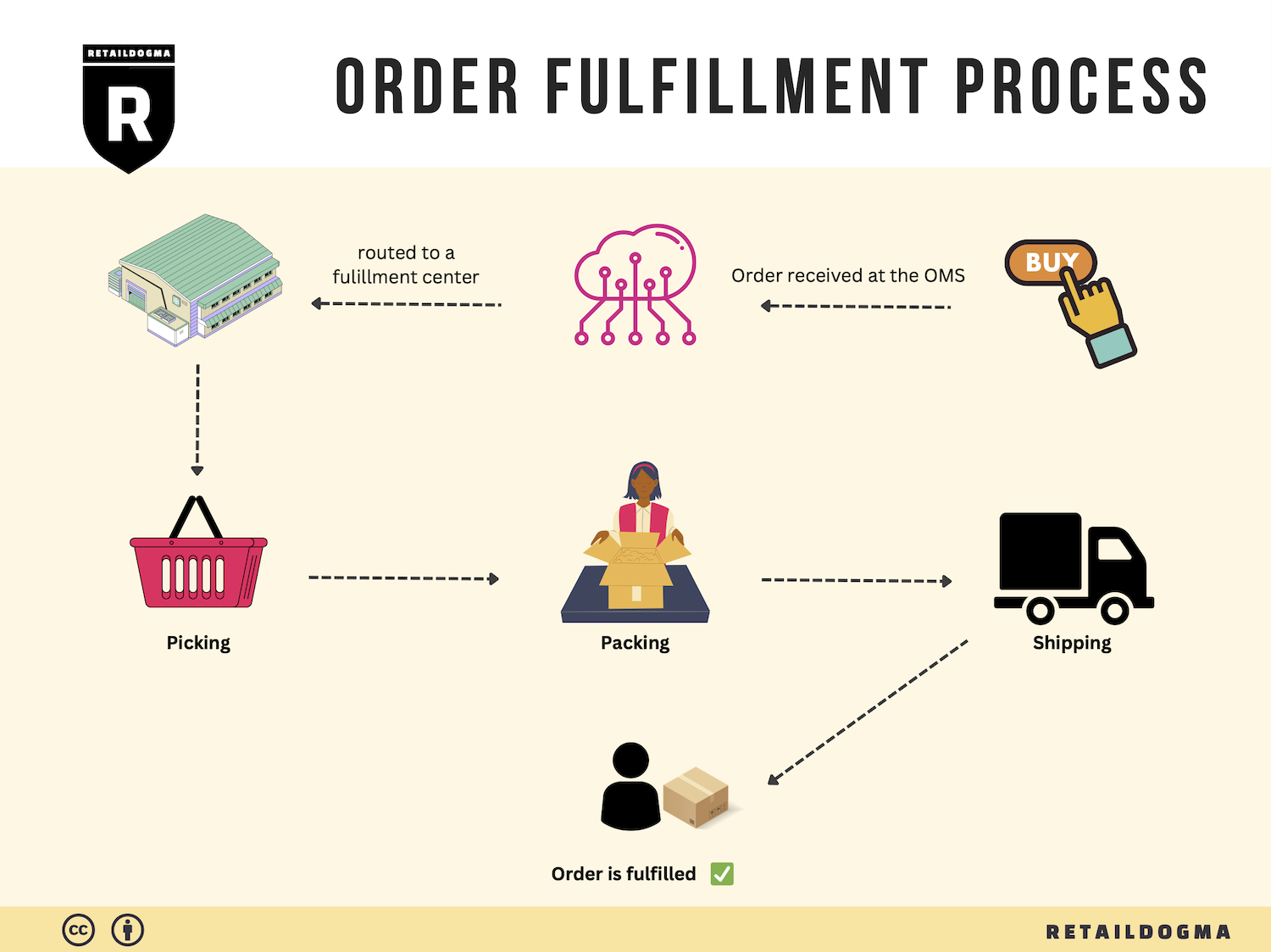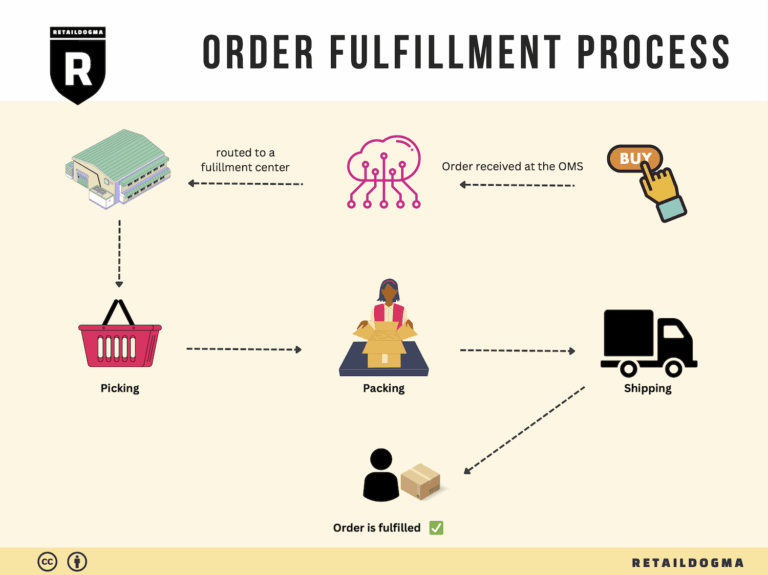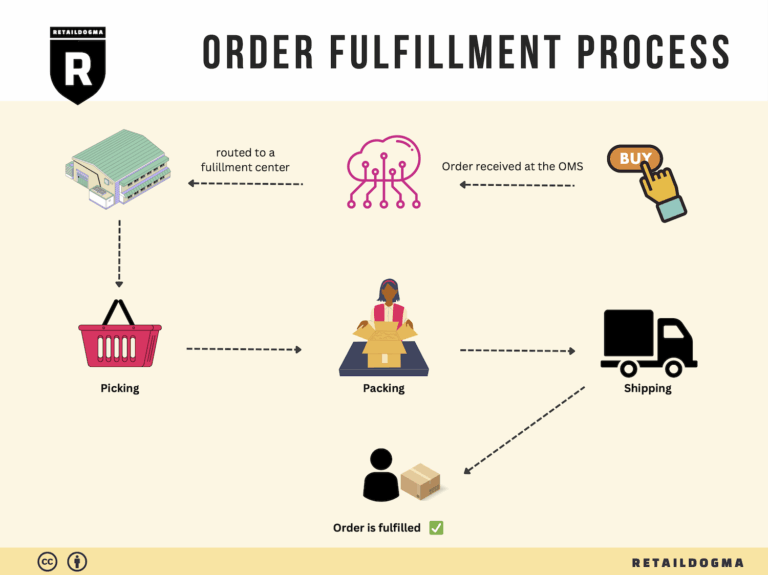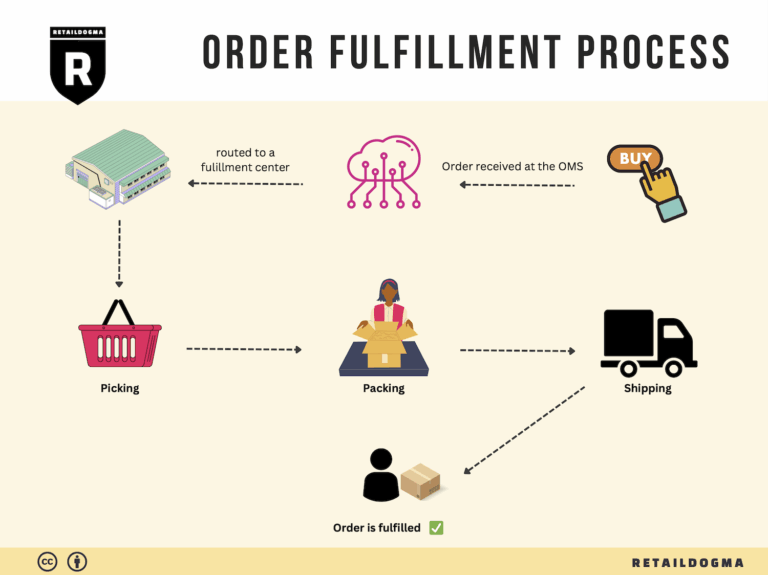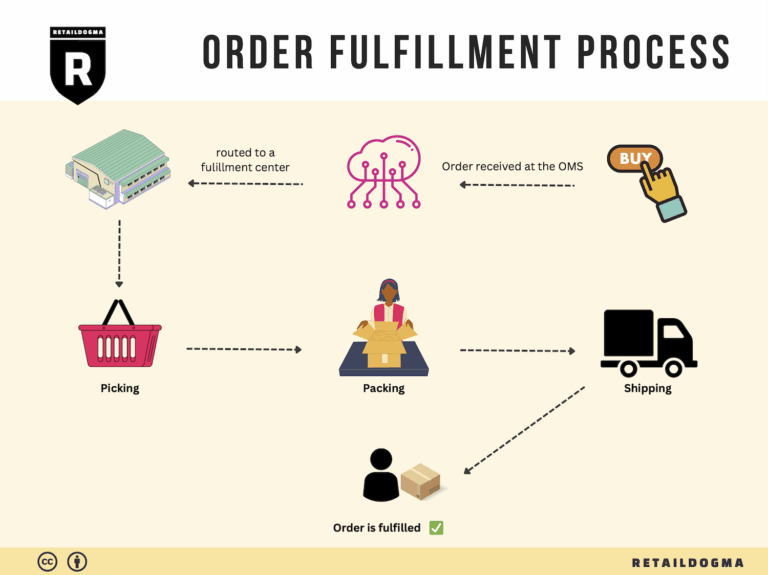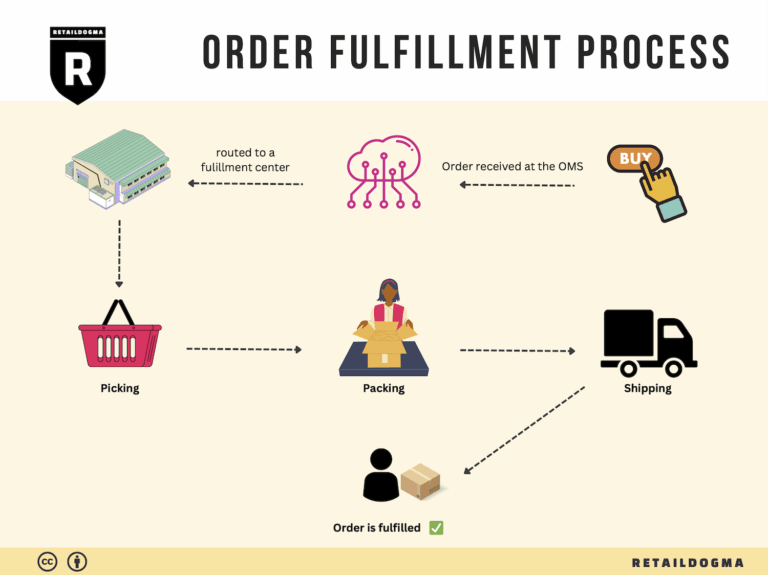How Order Fulfillment Works: A Step-by-Step Guide for Businesses
What is E-commerce Fulfillment? An Introduction for Growing Businesses
Understanding E-commerce Fulfillment: Navigating Growth Challenges
As an e-commerce business owner, you’re likely familiar with the exhilarating yet overwhelming journey of scaling your operations. One common pain point many entrepreneurs face is the complexity of packing and shipping orders. Managing inventory, ensuring timely deliveries, and maintaining customer satisfaction can quickly become a daunting task, especially as your sales volume increases. This is where e-commerce fulfillment comes into play.
E-commerce fulfillment is simply the process of getting a product into the hands of your customer. This multifaceted operation encompasses everything from receiving inventory, storing products, picking and packing orders, to shipping them directly to customers. As your business grows, understanding the intricacies of fulfillment becomes crucial to your success.
In this guide, we will explore several key aspects of e-commerce fulfillment to help you navigate this essential component of your business:
-
Fulfillment Models: We will delve into various fulfillment models, including Third-Party Logistics (3PL) and Fulfillment by Amazon (FBA). Each model offers unique advantages and may suit different types of businesses based on their specific needs, resources, and growth ambitions.
-
Core Services: You’ll learn about the core services provided by fulfillment partners, such as inventory management, order processing, shipping logistics, and returns handling. Understanding these services will enable you to choose a partner that aligns with your operational goals.
-
Choosing the Right Partner: The selection of a fulfillment partner can significantly impact your business operations. We’ll provide insights on what to look for in a partner, including technology integration, customer service, scalability, and cost-effectiveness.
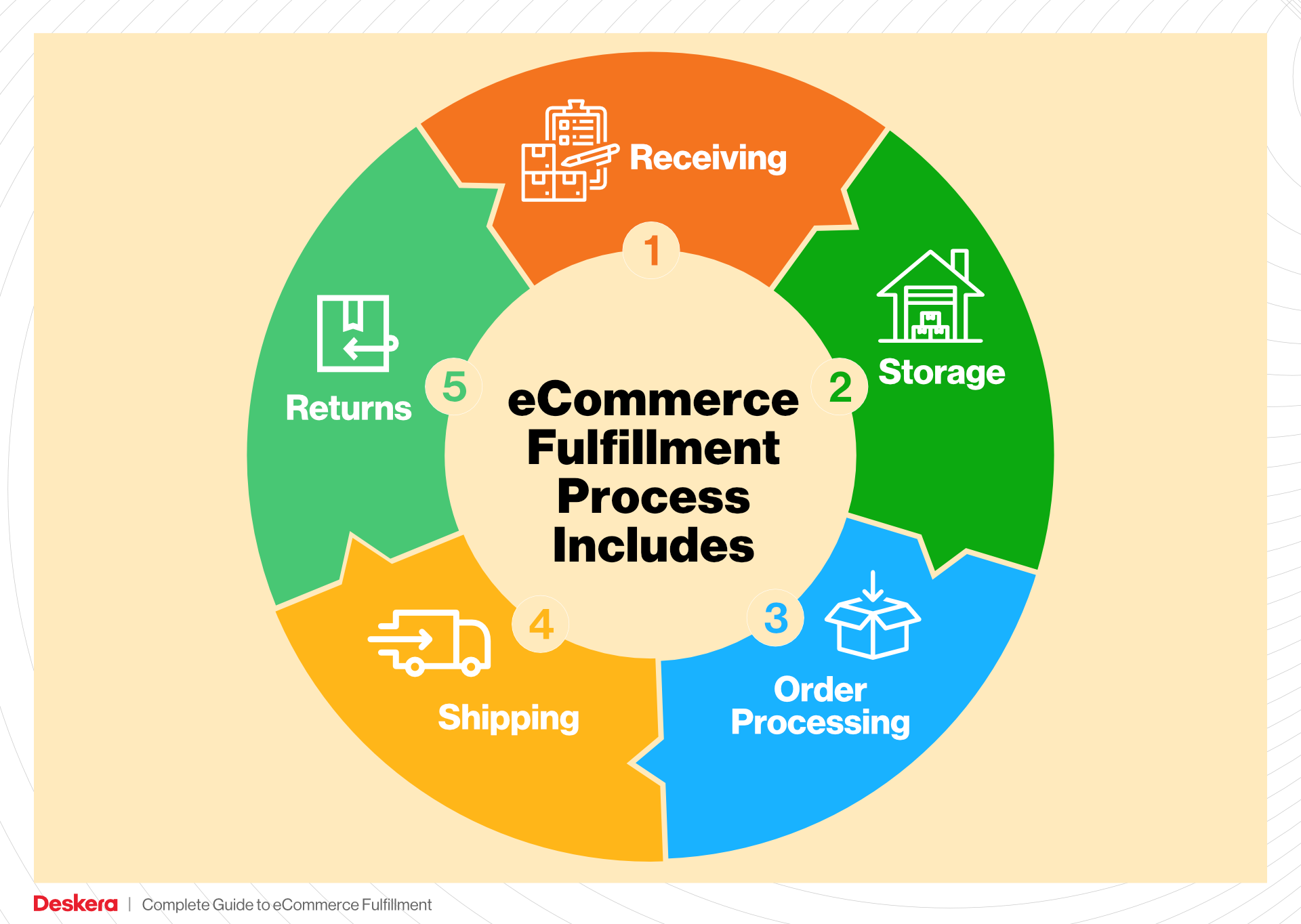
-
Pricing Considerations: Cost is a critical factor in any business decision. We’ll break down the pricing structures commonly associated with fulfillment services, helping you to budget effectively and understand the return on investment.
The goal of this guide is to empower you, as a growing business owner, to make informed decisions about your logistics. By understanding the fundamentals of e-commerce fulfillment, you can streamline your operations, enhance customer satisfaction, and ultimately drive growth. Whether you are just starting to explore fulfillment options or are looking to optimize your existing processes, this guide is designed to provide the clarity and confidence you need to succeed in the competitive e-commerce landscape.
What You’ll Learn In This Guide
- What is E-commerce Fulfillment? An Introduction for Growing Businesses
- The Order Fulfillment Process: From ‘Buy’ Button to Customer’s Door
- Comparing Fulfillment Models: In-House vs. 3PL vs. Dropshipping
- A Deep Dive into Amazon FBA: Pros, Cons, and Who It’s For
- Core Services Offered by Fulfillment Centers
- How to Choose a Fulfillment Partner: A 6-Point Checklist
- Understanding Fulfillment Pricing: A Breakdown of Common Fees
- Frequently Asked Questions (FAQs) about Fulfillment
- Conclusion: Is Outsourcing Fulfillment the Right Move for Your Business?
- Important Disclaimer
The Order Fulfillment Process: From ‘Buy’ Button to Customer’s Door
1. Receiving Inventory
The order fulfillment process begins with receiving inventory, a crucial step that sets the foundation for effective supply chain management. During this stage, products are delivered to the fulfillment center, where they are checked against purchase orders to ensure accuracy. This includes verifying quantities, inspecting for damages, and confirming that the correct items have arrived.
Importance: Accurate inventory receipt is essential to maintain stock levels and avoid discrepancies that can lead to order fulfillment errors down the line. An efficient receiving process helps prevent stockouts and enhances overall customer satisfaction.
Key Term: SKU (Stock Keeping Unit) – Each product is assigned a unique SKU, which simplifies tracking and management in inventory systems. This unique identifier facilitates accurate inventory management and supports quick retrieval during subsequent fulfillment stages.
2. Warehouse Storage
Once inventory is received and verified, it is stored in a designated area within the warehouse. This step involves organizing products in a systematic manner, often utilizing shelving systems, bins, or pallets to maximize space and improve accessibility. Strategic placement based on product demand and size can further enhance efficiency.
Importance: Proper warehouse storage is vital for optimizing order picking times and reducing operational costs. A well-organized warehouse minimizes the time spent searching for items and supports a streamlined workflow. This organization also plays a significant role in maintaining inventory accuracy.

Key Term: ABC Analysis – This inventory categorization technique divides products into three categories (A, B, and C) based on their importance and sales volume. Category A items are high-value products with low sales frequency, while Category C includes low-value products with high sales frequency. This method informs storage decisions, ensuring that frequently picked items are easily accessible.
3. Order Picking
Order picking is the process of selecting items from the warehouse to fulfill a customer’s order. Workers use various methods such as single order picking, batch picking, or zone picking, depending on the fulfillment strategy and order volume. Efficiency in this step is critical to meeting customer expectations, especially during peak shopping seasons.
Importance: The accuracy and speed of order picking directly impact customer satisfaction and operational efficiency. Errors in this phase can lead to incorrect orders, resulting in returns and increased customer service inquiries.
Key Term: Pick Lists – A pick list is a document or digital tool that outlines the items and quantities needed for each order. It serves as a guide for warehouse staff during the picking process, ensuring that all necessary items are gathered systematically and efficiently.
4. Order Packing
Once items have been picked, they move to the packing stage. Here, products are carefully packed into boxes or envelopes, with attention to protective measures to prevent damage during transit. Packing materials such as bubble wrap, packing peanuts, and sturdy boxes are used based on the product type and shipping method.
Importance: Effective packing is crucial not only for protecting items but also for optimizing shipping costs. Properly packed orders can minimize dimensional weight charges and ensure that items arrive in pristine condition, thereby enhancing the overall customer experience.
Key Term: Packing Slip – This document accompanies the shipment and includes details such as order contents, shipping address, and return instructions. It serves as a confirmation for both the customer and the fulfillment center, ensuring transparency and accuracy in the order.
5. Shipping & Delivery
The final step in the order fulfillment process is shipping and delivery. Once an order is packed, it is labeled and handed over to a shipping carrier. The choice of carrier and shipping method can influence delivery speed and cost, which are critical factors in customer satisfaction.
Importance: Timely delivery is a significant aspect of customer service in e-commerce. Delays can result in negative experiences and lost customers, making it essential for businesses to monitor shipping performance and ensure that orders are dispatched promptly.
Key Term: Last-Mile Delivery – This term refers to the final step in the shipping process, where the package is transported from a distribution center to the customer’s doorstep. Efficient last-mile delivery is key to achieving high customer satisfaction rates and can significantly impact operational costs.
By understanding and optimizing each step of the order fulfillment process, e-commerce businesses can enhance their efficiency, reduce costs, and ultimately improve customer satisfaction. Each phase, from receiving inventory to shipping and delivery, plays a pivotal role in ensuring a smooth, reliable experience for both the business and its customers.
Comparing Fulfillment Models: In-House vs. 3PL vs. Dropshipping
Fulfillment Model Comparison
| Model | Who Handles Inventory | Best For (Business Stage) | Key Advantage | Key Disadvantage |
|---|---|---|---|---|
| In-House Fulfillment | The business itself | Startups to Established | Full control over inventory and processes | High overhead costs and resource demands |
| Third-Party Logistics (3PL) | A specialized logistics provider | Established to Scaling | Cost-effective and scalable solutions | Less control over inventory and processes |
| Dropshipping | Suppliers or manufacturers | Startups and Small Businesses | Low upfront investment and risk | Longer shipping times and potential quality issues |
In-House Fulfillment
In-house fulfillment involves managing the entire logistics process within your own business. This includes handling inventory storage, order processing, packing, and shipping. Companies that opt for in-house fulfillment typically have a physical warehouse or storage space where they keep their products. This model offers a significant advantage: complete control over inventory management and fulfillment processes. Businesses can customize their operations to meet specific needs, ensuring high levels of order accuracy and customer satisfaction.
However, this model also comes with notable disadvantages. Maintaining an in-house fulfillment operation can be resource-intensive, requiring significant investment in labor, technology, and infrastructure. As a business scales, these overhead costs can become unsustainable, especially if order volume fluctuates. Additionally, the need for skilled staff to manage logistics effectively can add to the complexity and cost of this model. Therefore, while in-house fulfillment is suitable for startups wanting direct control, it may not be the most efficient choice as businesses grow and seek to optimize costs and scalability.
Third-Party Logistics (3PL)
Third-party logistics (3PL) providers, like Aero Fulfillment Services, manage the storage, fulfillment, and shipping of products on behalf of businesses. This model is ideal for established companies looking to scale their operations without the burden of managing logistics themselves. By outsourcing fulfillment to a 3PL, businesses can leverage the provider’s expertise, technology, and economies of scale. A significant advantage of using a 3PL is the cost-effectiveness achieved through reduced shipping rates and operational efficiencies, as these providers often have established relationships with carriers and advanced logistics technologies.
However, the key disadvantage of using a 3PL is the potential loss of control over inventory and fulfillment processes. Businesses may face challenges related to communication, inventory visibility, and the ability to respond quickly to changing market demands. Choosing the right 3PL partner is crucial, as misalignment in service levels can impact customer satisfaction. Overall, a 3PL is a robust solution for businesses looking to optimize their logistics without incurring the overhead costs associated with in-house fulfillment.
Dropshipping
Dropshipping is a fulfillment model where businesses sell products without holding inventory. Instead, when an order is placed, the business purchases the item from a third-party supplier who then ships it directly to the customer. This model is particularly attractive for startups and small businesses due to its low upfront investment and minimal risk. Entrepreneurs can test new products without worrying about storage costs or unsold inventory, making it a flexible option for entering the market.
Nevertheless, dropshipping comes with its own set of challenges. One major drawback is the reliance on suppliers for inventory and shipping, which can lead to longer shipping times and less control over product quality. Businesses may also struggle with inventory management, as stock levels can fluctuate unpredictably based on supplier capabilities. Additionally, customer service can be complicated; if issues arise with an order, the business must coordinate with suppliers to resolve them. As a result, while dropshipping is an appealing option for those looking to minimize risk, it may not be sustainable for businesses aiming for growth and higher customer satisfaction in the long term.
In conclusion, each fulfillment model presents unique advantages and disadvantages, and the best choice depends on the specific needs and growth stage of the business. Understanding these models will empower e-commerce entrepreneurs to make informed decisions that align with their operational goals and customer expectations.
A Deep Dive into Amazon FBA: Pros, Cons, and Who It’s For
Understanding Fulfillment by Amazon (FBA)
Fulfillment by Amazon (FBA) is a service provided by Amazon that allows e-commerce sellers to store their products in Amazon’s fulfillment centers. Amazon then takes care of storage, packaging, and shipping of the products, as well as handling customer service and returns. This service has become increasingly popular among small and medium-sized businesses looking to leverage Amazon’s vast logistics network and customer base.
When a customer places an order for an FBA product, Amazon picks, packs, and ships the order on behalf of the seller. The seller retains ownership of the inventory, but Amazon takes care of the entire fulfillment process. Sellers can also benefit from Amazon’s customer service for those orders, which can alleviate some of the burdens of running an e-commerce business.
How FBA Works
-
Set Up Your FBA Account: Sellers first need to create an Amazon seller account and enroll in the FBA program. Once enrolled, they can list their products as FBA items.
-
Ship Products to Amazon: Sellers send their inventory to Amazon’s fulfillment centers. Amazon provides guidance on how to prepare and package products to meet their standards.
-
Storage and Management: Once the products arrive at Amazon, they are stored in Amazon’s warehouses. Sellers can manage their inventory through the Amazon Seller Central dashboard, which provides real-time data on stock levels and sales.
-
Order Fulfillment: When a customer orders an FBA product, Amazon takes over. They pick the item from the warehouse, pack it, and ship it directly to the customer.
-
Customer Service and Returns: Amazon handles all customer service inquiries and processes returns for FBA orders, providing a seamless experience for customers.
-
Payments: Sellers receive payments for their sales, minus Amazon’s fees, typically every two weeks.
Pros of Using FBA
-
Prime Eligibility: One of the most significant advantages of using FBA is that products become eligible for Amazon Prime. This can significantly boost sales, as Prime members tend to prefer products that offer free, fast shipping.
-
Customer Trust: Amazon is a trusted brand. By utilizing FBA, sellers can benefit from Amazon’s reputation, which can lead to increased customer trust and higher conversion rates.
-
Multi-Channel Fulfillment: FBA isn’t limited to Amazon sales alone. Sellers can use FBA to fulfill orders from other channels, such as their own e-commerce websites, which can streamline operations.
-
Scalability: As businesses grow, FBA allows sellers to scale without needing to invest in their own storage and logistics infrastructure.
-
Automated Customer Service: Amazon handles customer service and returns for FBA orders, allowing sellers to focus on other aspects of their business.
Cons of Using FBA
-
High Fees: FBA comes with several fees, including storage fees for keeping inventory in Amazon’s warehouses and fulfillment fees for each order. These costs can add up quickly, especially for sellers with low-margin products.
-
Strict Inventory Rules: Amazon has stringent requirements for inventory management, including labeling, packaging, and storage limits. Sellers must adhere to these guidelines to avoid penalties.
-
Commingling Risks: FBA products may be commingled with those from other sellers. This means that if a customer returns a product, it could be difficult to determine which seller it came from, potentially leading to issues with damaged or unsellable inventory.
-
Less Control Over Branding: While using FBA, sellers have less control over the packaging and branding of their products, which can dilute brand identity.
-
Dependency on Amazon: Relying on FBA can create a dependency on Amazon’s platform. Changes in Amazon’s policies, fees, or algorithms can significantly impact sellers’ businesses.
Who is FBA Best For?
Fulfillment by Amazon is particularly beneficial for:
-
Small to Medium-Sized Sellers: Businesses looking to scale quickly without investing heavily in logistics can leverage FBA to access Amazon’s vast distribution network.
-
Sellers of High-Turnover Products: If your products have a high turnover rate, the convenience of FBA can outweigh the associated costs.
-
E-commerce Entrepreneurs Seeking Brand Trust: New sellers who want to establish credibility and trust with customers can benefit from Amazon’s reputation.
-
Multi-Channel Sellers: Businesses selling on multiple platforms can utilize FBA to streamline their fulfillment processes and maintain consistent service levels.
-
Businesses with Limited Resources: Companies that lack the infrastructure to manage logistics and fulfillment effectively can rely on FBA to handle these aspects.
In conclusion, while Fulfillment by Amazon offers numerous advantages, such as increased visibility and customer trust, it is essential for sellers to carefully consider the associated costs and operational implications. By understanding both the pros and cons, e-commerce business owners can make informed decisions about whether FBA aligns with their growth strategies and operational capabilities.
Core Services Offered by Fulfillment Centers
Inventory Management & Warehousing
Effective inventory management is crucial for e-commerce businesses aiming to scale. Fulfillment centers offer specialized inventory management services that allow businesses to maintain optimal stock levels while minimizing costs. These centers utilize advanced technology to track inventory in real-time, providing businesses with critical insights into stock levels, order status, and product movements.
Benefits:
1. Real-Time Visibility: E-commerce businesses gain immediate access to inventory data, helping them make informed decisions regarding stock replenishment and order fulfillment.
2. Reduced Overheads: By outsourcing warehousing, businesses can lower costs associated with maintaining their own storage facilities, including rent, utilities, and staffing.
3. Strategic Location: Many fulfillment centers, like Aero Fulfillment, are strategically located to ensure efficient shipping across major markets. This positioning reduces transit times and shipping costs, enhancing customer satisfaction.
Pick and Pack Services
Pick and pack services are at the heart of fulfillment operations. This process involves selecting the ordered items from inventory (picking) and packaging them for shipment (packing). Fulfillment centers streamline this process to ensure efficiency and accuracy, which are vital for maintaining customer trust.
Benefits:
1. Speed and Accuracy: With dedicated teams and optimized processes, fulfillment centers can significantly reduce the time it takes to process orders, often offering same-day fulfillment. This speed is essential for meeting customer expectations, especially in today’s fast-paced market.
2. Error Reduction: Automated systems and trained personnel minimize the risk of errors during order fulfillment. High accuracy rates lead to fewer returns and increased customer satisfaction.
3. Scalability: As e-commerce businesses grow, their order volumes can fluctuate significantly. Fulfillment centers can easily scale their pick and pack operations to accommodate these changes without the need for businesses to invest in additional resources.
Kitting and Assembly
Kitting and assembly services involve combining multiple products into a single package or preparing items for sale. This could include assembling products, creating gift sets, or preparing subscription boxes. Fulfillment centers offer these services to streamline the process and enhance the overall customer experience.
Benefits:
1. Customization: Kitting allows businesses to offer personalized products and bundles, which can enhance customer engagement and boost sales. This is particularly beneficial for subscription services or promotional campaigns.
2. Time Efficiency: By outsourcing kitting and assembly, businesses can save time and focus on core activities such as marketing and product development. Fulfillment centers handle the complexity of assembling products, freeing up valuable resources.
3. Inventory Optimization: Kitting can help manage inventory more effectively by reducing the number of individual SKUs that need to be tracked. This simplification can lead to better inventory turnover and reduced holding costs.
Returns Management (Reverse Logistics)
Returns management, or reverse logistics, is a critical service offered by fulfillment centers that facilitates the handling of product returns. An efficient returns process is essential for maintaining customer satisfaction and loyalty, as it directly impacts the shopping experience.
Benefits:
1. Streamlined Processes: Fulfillment centers implement systematic procedures for processing returns, ensuring that items are assessed, restocked, or disposed of quickly and efficiently. This reduces the time and costs associated with returns.
2. Customer Satisfaction: A hassle-free return experience fosters customer trust and encourages repeat purchases. Fulfillment centers can provide return labels, tracking, and timely refunds, enhancing the overall shopping experience.
3. Data Insights: Analyzing return data can provide valuable insights into product quality and customer preferences. This information can help businesses make informed decisions about inventory, product offerings, and marketing strategies.
In conclusion, partnering with a fulfillment center offers e-commerce businesses a comprehensive suite of services designed to enhance operational efficiency and customer satisfaction. By leveraging expertise in inventory management, order fulfillment, kitting, and returns management, businesses can focus on scaling their operations while ensuring that their logistics run smoothly.
How to Choose a Fulfillment Partner: A 6-Point Checklist
Location & Warehouse Network
The geographical location of your fulfillment partner’s warehouses plays a pivotal role in determining shipping costs and delivery times. A partner with strategically placed warehouses can ensure faster deliveries and reduced shipping zones, enhancing customer satisfaction.
Key Questions to Ask:
– Where are your warehouses located, and how does this benefit my shipping strategy?
– What percentage of the U.S. population can be reached within a specific timeframe from your facilities?
– Do you have plans for expansion or additional warehouses in key locations?
Technology & Integrations
In today’s e-commerce landscape, technology is critical for seamless operations. A fulfillment partner should offer robust technology solutions that integrate smoothly with your e-commerce platform. This ensures real-time inventory tracking, order processing, and customer communication, leading to reduced errors and improved efficiency.
Key Questions to Ask:
– What e-commerce platforms and systems do you integrate with (e.g., Shopify, WooCommerce, Amazon)?
– Can you provide real-time updates on inventory, orders, and shipments through your system?
– What kind of reporting and analytics do you offer to help us monitor our fulfillment performance?
Specializations (e.g., Cold Storage, Oversized Items)
Different businesses have unique fulfillment needs. If your products require special handling—such as cold storage for perishables or specific protocols for oversized items—it’s crucial to partner with a fulfillment provider that specializes in those areas.
Key Questions to Ask:
– What specific services do you offer for specialized products (e.g., food-grade storage, kitting, or assembly)?
– Are your facilities equipped to handle my specific product requirements?
– Can you demonstrate compliance with industry regulations relevant to my products (e.g., FDA for food items)?
Scalability & Capacity
As your business grows, so will your fulfillment needs. Your partner should have the capacity and flexibility to scale operations in line with your growth, whether it’s handling increased order volumes or managing seasonal spikes in demand.
Key Questions to Ask:
– How do you manage scalability during peak seasons or unexpected demand surges?
– What is your current capacity, and how quickly can you expand to accommodate my growth?
– Can you provide case studies or examples of how you’ve supported other clients during their scaling phases?
Pricing and Contracts
Understanding the pricing structure and contract terms is essential to ensure that you are getting value for your investment. Look for transparency in pricing to avoid hidden fees, and ensure that the contract aligns with your business objectives.
Key Questions to Ask:
– Can you provide a detailed breakdown of your pricing model (e.g., storage fees, pick-and-pack fees, shipping costs)?
– Are there any additional charges I should be aware of (e.g., for returns, inventory management)?
– What are the terms of your contract, and is there flexibility for renegotiation based on performance?
Customer Support & Reviews
Reliable customer support is vital for a smooth partnership. A fulfillment provider should offer dedicated support to address issues promptly and effectively. Additionally, researching reviews and testimonials can provide insight into the partner’s reliability and service quality.
Key Questions to Ask:
– What type of customer support do you offer (e.g., dedicated account manager, 24/7 support)?
– How do you handle issues or discrepancies in order fulfillment?
– Can you share references or case studies from clients in my industry, and what feedback have you received from them?
By carefully evaluating these key areas, e-commerce business owners, operations managers, and entrepreneurs can make informed decisions when selecting a fulfillment partner. This checklist will help ensure that you choose a partner who can support your business’s growth and operational efficiency while meeting your specific needs.
Understanding Fulfillment Pricing: A Breakdown of Common Fees
Initial Setup Fees
Initial setup fees are typically charged when you first engage a fulfillment service provider. This fee covers the administrative and technical costs associated with integrating your systems with their fulfillment platform. It may include setting up your account, configuring your product listings, and ensuring that your inventory management system is aligned with the fulfillment center’s operations.
Calculation: The fee can vary widely based on the complexity of your needs. Some providers charge a flat fee, while others may calculate costs based on the number of SKUs (stock-keeping units) you have or the time required to complete the setup. It’s essential to clarify what is included in this fee and whether there are any ongoing support costs associated with your account.
Receiving Fees
Receiving fees are incurred each time inventory is delivered to the fulfillment center. This fee covers the costs of unloading, inspecting, and cataloging your products. It’s crucial for maintaining accurate inventory records and ensuring that the right products are available for fulfillment.
Calculation: Receiving fees are often charged per pallet or per hour spent processing your incoming inventory. Some providers may have a tiered pricing structure, where the fee per unit decreases as the volume of shipments increases. Understanding how your inventory will be received can help you anticipate these costs.
Storage Fees (per pallet/bin)
Storage fees are charged for the space your inventory occupies within the fulfillment center. These fees can significantly impact your overall fulfillment costs, especially if you have a large inventory or if your products are bulky.
Calculation: Storage fees are generally calculated on a per pallet or per bin basis, often billed monthly. Some providers may offer different rates depending on the size of the items, with larger items incurring higher fees. Additionally, there may be seasonal fluctuations in storage fees, particularly during peak shopping periods when demand is high, and warehouse space becomes more limited.
Pick & Pack Fees (per item/order)
Pick and pack fees are charged for the labor involved in picking items from the warehouse and packing them for shipment. This fee is crucial for understanding the operational costs associated with fulfilling each order.
Calculation: Pick and pack fees can be structured in various ways. Some providers charge a flat fee per order, while others charge based on the number of items in the order. This means that larger orders may incur higher fees. It’s important to clarify what constitutes a “pick” and how the fee is calculated—whether it includes materials like packing slips and boxes or if those are billed separately.
Shipping Fees
Shipping fees are among the most variable costs in the fulfillment process, as they depend on factors such as package weight, dimensions, shipping destination, and the carrier used. These fees can significantly affect your overall fulfillment costs and pricing strategy.
Calculation: Shipping fees are typically calculated based on the weight and size of the package, as well as the shipping method chosen (e.g., standard, expedited, overnight). Many fulfillment centers have established relationships with carriers, allowing them to pass on discounted rates to clients. Understanding how shipping costs are calculated and whether your provider offers competitive rates is essential for budgeting.
Tips for Getting an Accurate Quote
-
Be Transparent About Your Needs: Provide detailed information about your inventory, order volume, and any specific requirements you have for fulfillment. The more information you share, the more accurate the quote will be.
-
Ask About All Potential Fees: Ensure you understand all the fees that could apply to your business model. Inquire about potential surcharges, seasonal fees, or additional costs for special handling.
-
Consider Volume Discounts: If you anticipate scaling your operations, ask if the fulfillment provider offers volume discounts. This can lead to significant savings as your business grows.
-
Request a Detailed Breakdown: Ask for a comprehensive breakdown of the pricing structure, including all fees associated with setup, storage, and fulfillment. This transparency will help you make informed decisions.
-
Evaluate Long-Term Costs: While initial quotes may seem attractive, consider the long-term implications of each fee structure. A slightly higher initial cost may result in better service and lower overall costs down the line.
By understanding these common fulfillment pricing models and following these tips, you can better navigate the complexities of fulfillment services and make informed decisions that support your e-commerce growth.
Frequently Asked Questions (FAQs) about Fulfillment
1. What is Aero Fulfillment Services?
Aero Fulfillment Services specializes in e-commerce fulfillment, providing businesses with efficient and accurate order processing, inventory management, and shipping solutions. Our tech-enabled facilities are strategically located to ensure fast delivery and cost-effective services, allowing you to focus on scaling your business while we handle the logistics.
2. How does Aero Fulfillment reduce shipping costs for my business?
Aero Fulfillment leverages high-volume shipping discounts obtained through partnerships with major carriers. Our centralized location, positioned within a day’s drive of over 60% of the U.S. population, minimizes shipping zones, thereby reducing costs. With transparent pricing and no hidden fees, you can better manage your logistics budget.
3. What is the difference between a warehouse and a fulfillment center?
A warehouse primarily serves as a storage space for inventory, while a fulfillment center is designed to handle the entire order processing workflow—from receiving and storing products to picking, packing, and shipping them directly to customers. Fulfillment centers focus on optimizing speed and efficiency to enhance customer satisfaction, making them ideal for e-commerce businesses.
4. What is a 3PL (Third-Party Logistics)?
A 3PL, or Third-Party Logistics provider, is a company that offers outsourced logistics services, including warehousing, fulfillment, and transportation. By partnering with a 3PL like Aero Fulfillment, businesses can leverage specialized expertise, advanced technology, and scalable solutions to improve operational efficiency and reduce costs.
5. How quickly can Aero Fulfillment get my business set up?
We aim to get you operational as swiftly as possible, typically within 2-4 weeks, depending on the complexity of your needs. Our streamlined onboarding process ensures that you can start fulfilling orders quickly, with minimal disruption to your business operations.
6. Does Aero Fulfillment integrate with popular e-commerce platforms?
Yes, Aero Fulfillment seamlessly integrates with major e-commerce platforms such as Shopify, WooCommerce, and Amazon. This integration allows for real-time updates on inventory levels, order statuses, and shipments, enhancing operational efficiency and improving customer satisfaction.
7. How does Aero support inventory management for e-commerce businesses?
Aero Fulfillment employs advanced inventory management systems that provide real-time visibility into stock levels, order status, and product movements. This system helps prevent stockouts, minimizes excess inventory, and streamlines reordering processes, ensuring you are always prepared to meet customer demand.
8. What are the typical costs associated with fulfillment services?
Fulfillment service costs can vary based on factors such as order volume, inventory size, and specific services required (e.g., kitting, assembly, or special handling). Aero Fulfillment offers transparent pricing structures with no hidden fees, allowing you to understand your costs upfront and budget accordingly.
9. How does Aero Fulfillment ensure order accuracy?
Aero Fulfillment maintains a high order accuracy rate of 99.90% through meticulous processes and quality control measures. Our team is trained to handle orders carefully, and we utilize advanced technology to track and verify orders throughout the fulfillment process, ensuring that customers receive the correct items promptly.
10. Can I track my orders in real-time with Aero Fulfillment?
Absolutely! Aero Fulfillment provides real-time tracking capabilities for all orders processed through our system. You will have access to up-to-date information regarding inventory levels, order statuses, and shipment tracking, enabling you to keep your customers informed and satisfied throughout the delivery process.
Conclusion: Is Outsourcing Fulfillment the Right Move for Your Business?
Evaluating the Benefits of Outsourcing Fulfillment
In today’s fast-paced e-commerce landscape, outsourcing fulfillment can be a game-changer for many businesses. By leveraging a specialized fulfillment service, you can save significant time and resources that would otherwise be spent on managing logistics. This allows you to focus on core business activities such as marketing, product development, and customer engagement. The streamlined processes provided by a fulfillment partner can enhance order accuracy and speed, ultimately leading to greater customer satisfaction.
Scalability is another critical advantage of outsourcing fulfillment. As your business grows, so too does the complexity of your logistics operations. A reputable fulfillment partner, like Aero Fulfillment Services, can seamlessly adapt to your evolving needs, whether that means handling increased order volumes during peak seasons or managing a wider range of SKUs. This flexibility enables you to scale operations without the headache of overhauling your internal systems or investing in additional infrastructure.
Expertise is yet another compelling reason to consider outsourcing. Fulfillment services bring decades of industry experience and advanced technology to the table, ensuring that your logistics processes are handled by professionals who understand the nuances of the market. This expertise not only mitigates risks but also enhances your operational efficiency, making it easier to meet customer demands.
Choosing the right fulfillment partner is crucial for your business’s growth trajectory. It’s essential to align with a provider whose capabilities match your specific needs and who demonstrates a commitment to your success.
To determine if outsourcing fulfillment is the right next step for your business, conduct a thorough audit of your current shipping processes. Evaluate the time, costs, and resources involved, and consider how a fulfillment service could streamline these elements. This strategic assessment can provide clarity on whether a partnership could be your pathway to greater efficiency and growth.
Important Disclaimer
⚠️ Important Disclaimer
The information in this guide is for educational purposes. Fulfillment services, pricing, and platform features change frequently. Always conduct your own due diligence and consult with providers directly before making business decisions.
